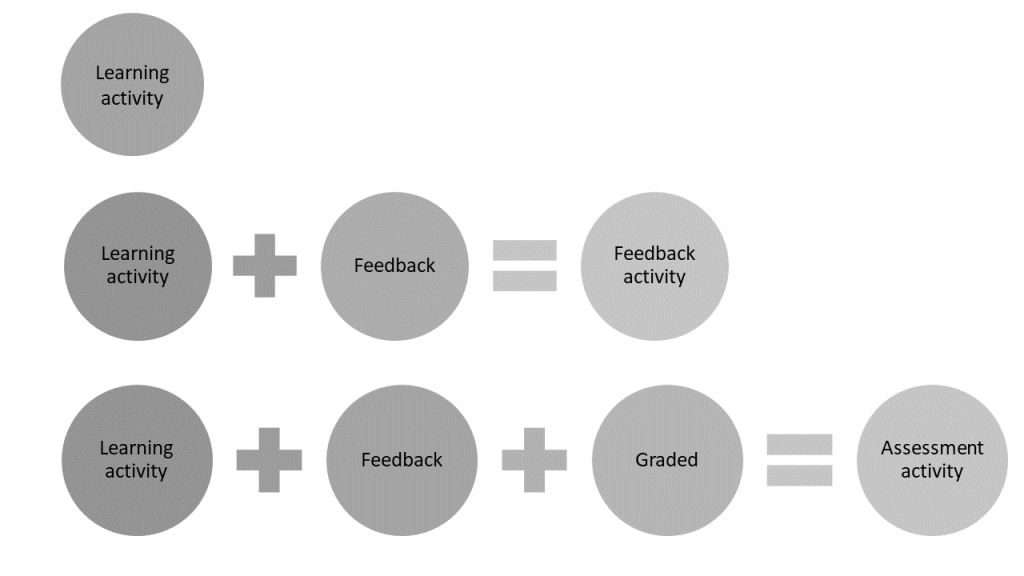
Image by Macrovector from Freepik
Activities everywhere
Opinion: Design your course with activities for learning, feedback and assessment
written JJ Cloutier and edited by Debra Sinkarsin
Preface
During a morning check-in between MB Hub’s instructional designer, Ariful Hoq Shanil, and myself, what started as a lively conversation ended with this blog post. Ariful explained activities and assessments as defined by Quality Matters. Then a debate of sorts occurred; I kept asking more and more questions, poking at things, and looking for clarity in the Quality Matters standards. Ultimately, it led me to research and build an educational structure to help synthesize my understanding for this blog post.
Note: This approach applies to graded courses and not ungraded courses.
Researching for a resource page
We’ve been working on an activity resource page, and in searching for activities, I ran into an overlap of activities that were also used as assessments. What constituted an activity, and what constituted an assessment? Wait, I have two types of assessments: formative and summative. Examples of activities like concept maps only confused me further as they were used as an activity, a formative assessment or a summative assessment.
I needed to find the logic and understand the relationship between activities and assessments. I figure students and early career instructors might be facing the same struggle.
My goal of this (opinion) blog post is to help:
- Provide a structure that was practical and helped instructors design courses with clarity.
- Explain to students how the same activity might be used differently in their course depending on the purpose.
Start with understanding activity
UNESCO (2011) defined an educational activity as “a deliberate activity involving some form of communication intended to bring about learning.”
In other words, instructors design activities for the learners, which are communicated to the learners and learners learn from these activities.
What is not an activity? It seems like all the content you create when it is engaged in and the assessment you provide is an activity. So, your course is designed with activities. But not all activities have the same purpose.
The foundational purpose
Standford’s Teaching Commons and the University of Waterloo Centre for Teaching Excellence add the word “Learning” in front of traditional “activities,” which signifies their foundational purpose of promoting learning.
UNESCO (2011) defines learning activities as “deliberate activity in which an individual participates with the intention to learn.”
In the glossary of terminology from Quality Matters Higher Education Rubric, Seventh Edition, activity is defined as “any assigned course activity that allows students to practice using the new knowledge and skills they are learning in the course. Activities allow for practice, discovery, and trial and error. Examples of activities include low stakes, untimed quizzes that learners can take multiple times, and drag-and-drop exercises following a video lecture on a new topic. ”
What separates activity from instructional materials is the participation of the learner. You gather, select or create course content, but the act of consuming the course materials makes it a learning activity.
The foundational educational activity we design into a course is the “learning activity.”
Defining assessment as purpose
Going back to UNESCO (2011), an “Assessment of learning outcome” is the “Evaluation of an individual’s achievement of learning objectives, using a variety of assessment methods (written, oral and practical tests/examinations, projects and portfolios) during or at the end of an education programme.”
Quality Matters Higher Education Rubric, Seventh Edition, when defining assessments as instruments (not a process), said, “Assessments measure what students have learned; specifically, they measure learner achievement of Learning objectives.”
General Standard 3 from Standards from the Quality Matters Higher Education Rubric, Seventh Edition, covers assessment and details the use of course grading policies and evaluation criteria.
Traditionally, instructors have designed “summative assessments” as activities to determine if the student has met the learning objective(s). Summative assessments are evaluated and then graded. Grades might be assigned such as with a letter grade, numerical value or pass or fail.
So, we have another category of activity called an “Assessment activity” that we design into a course.
Discovering the other purpose
The third type of activity I found was the muddiest type of activity, and well, a genesis for reflecting on all the terms. I found activities designed into a course that were not graded but were more than learning activities.
The majority of teaching and learning centres use formative assessment to describe these activities. University of Waterloo’s Centre for Teaching Excellence uses the term assignment to help clarify how it differs from assessments. “When the two terms are distinguished, ‘assignment’ tends to refer to a learning activity that is primarily intended to foster or consolidate learning, while ‘assessment’ tends to refer to an activity that is primarily intended to measure how well a student has learned.” (Centre for Teaching Excellence, n.d.)
Formative assessments, according to Standford’s Teaching Commons (n.d.), “are usually meant to measure learning in order to provide feedback.”
Combining the two, these activities foster and consolidate learning through feedback but without assigning a grade to them.
I am summing up this third category of activities as “Feedback activity.”
Results: Three types of activities
Through this reflective process, a structure of educational activities based on purpose emerged: learning, feedback, and assessment activities. Also, I saw that the structure was additive in nature. You could have a learning activity which adds feedback to create a feedback activity. A feedback activity with grading to create an assessment activity. It makes sense that a concept map can be used as a learning, feedback or assessment activity.
I then interwove some components of Quality Matters into this educational activity structuring.
A learning activity is:
- a deliberate activity designed into the course intended to promote learning.
- not evaluated, measured or otherwise used to calculate the learner’s grade directly. (No grade is recorded.)
- an activity that aligns with a portion, a single objective or multiple learning objectives.
Examples: Completing readings, watching videos, participating in class discussions, reviewing a concept map in class or practicing taking apart a motorcycle engine in lab time.
A feedback activity is:
- a deliberate activity designed into the course intended to promote learning and provides the learner feedback. The feedback could be self-reflective feedback, peer feedback, instructor or LMS feedback.
- not used to calculate the learner’s grade directly. (No grade is recorded.)
- an activity that aligns with a portion, a single objective or multiple learning objectives.
Examples: Discussion board (with feedback given), close reading (with peer feedback), test your knowledge quizzes in LMS, and feedback on scaffolded (draft) concept map assessment.
An assessment activity is:
- a deliberate activity designed into the course intended to promote learning that provides the student feedback and is used to evaluate an individual’s achievement of learning objectives.
- used to calculate the learner’s grade directly.
- an activity that aligns with a single, multiple, or all module or course learning objectives. (Specific review standard 3.1, Standards from the Quality Matters Higher Education Rubric, Seventh Edition)
- an activity with criteria for evaluation of the learner’s work that is specific and descriptive and available to the learner (Specific review standard 3.3, Standards from the Quality Matters Higher Education Rubric, Seventh Edition)
Examples: In-class presentations, open book exam, final concept map for module, poster assignment, podcast.
I then created this illustration for visualization purposes: review image 1: Educational activity structure.
Image 1: Educational activity structure

Image by JJ Cloutier
Long description of “Educational activity structure”
Equation smart art with three lines. Each phrase is in a circle. In between the circles are math symbols.
- The first line is “learning activity” in a circle.
- The second line is “learning activity” plus “feedback” equals “feedback activity.”
- The third line is “learning activity” plus “feedback” plus “graded” equals “assessment activity.”
References
Centre for Teaching Excellence-b (n.d.). Types of Assignments and Assessments University of Waterloo. https://uwaterloo.ca/centre-for-teaching-excellence/catalogs/tip-sheets/types-assignments-and-assessments
Quality Matters. (2023). Quality Matters Higher Education Rubric, Seventh Edition. Retrieved from Specific Review Standards from the QM Higher Education Rubric, Seventh Edition
Teaching commons. (n.d.). Learning activities. Stanford University. https://teachingcommons.stanford.edu/teaching-guides/foundations-course-design/learning-activities
UNESCO. (2011). International Standard Classification of Education (ISCED) 2011. https://uis.unesco.org/sites/default/files/documents/international-standard-classification-of-education-isced-2011-en.pdf
